Anthony Metivier's Blog, page 24
September 18, 2019
How Mike McKinley Memorized 66 Psalms WITHOUT A Memory Palace
 Do you struggle with the Memory Palace technique to complete large learning goals?
Do you struggle with the Memory Palace technique to complete large learning goals?
For example, have you always wanted to memorize a substantial body of scripture, but…
Kept putting it off?
I know, I know…
We all have something in our life that continuously gets pushed to the bottom of our never-ending to-do list…
We all say “I’ll eventually get around to it”…
We’re all guilty of never making moves to cross that item off our list.
And yet…
My guest for this podcast, Mike McKinley, has managed to AVOID that mistake when it came to making steps toward completing one MASSIVE goal.
Mike is an alumni of the Magnetic Memory Method Masterclass. He is also an electrical engineer and specialist in the area of radio frequencies.
On top of those duties, Mike is a husband, father, seminary graduate, and full-time employee. Using the memory techniques he’s learned from the MMM Masterclass, he completed a three-year seminary course and memorized 66 chapters of the Psalms (and counting)!

So if you’re intimidated by the idea of undertaking an entire course to improve your memory…
If you feel as though you don’t have the time to commit in an already packed schedule…
Or you think, “How could I ever memorize something so lengthy?”…
Just click play on the button above now and learn from Mike all about:
Why information is easier to remember in story form
The reason early Christians memorized the scriptures
Why recitation is an important memory improvement exercise
How actors and memory students are one and the same
The way manufacturing “spoiled us” with uniformity
The importance of small memorization goals and practicing the loci method when taking on large learning projects
The role of visualization exercises in memorization
The role of compounding or compressing in memorization
A tip on how to “reuse” celebrities, like actors, multiple times as symbols in memory work
The way long-form memorization is like running a marathon
The reason dogma has no place in the world of memory training and why memory is a creative event
Of course, you might be thinking…
What if I Want To Memorize Scripture In Another Language?
No problem!
Check out this incredible success story from one of Mike’s fellow Magnetic Memory Method students:

(For more success stories, please visit the Magnetic Memory Method review page.)
Like Jeannie, I also use a Memory Palace for memorizing scripture in other languages.
Here’s a demonstration and discussion of how I make it work with a Sanskrit text called Ribhu Gita:
What’s the secret to this memory method?
Easy:
Take it one S.I.P. at a time:
Study memory techniques
Implement what you learn progressively so you improve your…
Practice (daily is best)
It really doesn’t get any easier than that, and the outcomes of having scripture in your mind and heart are profound.
Dive in!
Further Resources on the Web, this podcast, and the MMM Blog:
How to Memorize Scripture And Verse Numbers In 5 Minutes Or Less (MMM Blog)
The Good, The Bad & The Wicked Charlatans of Vocabulary Memorization
3 POWERFUL Elaborative Encoding Memory Exercises (MMM Blog)
4 Powerful Ways to Use the Pegword Method [10 Examples Included] (MMM Blog)
12 Brain Exercises To Improve Memory (Step-By-Step Tutorial) (MMM Blog)
How Do You Choose What Bible Passages to Memorize?
The post How Mike McKinley Memorized 66 Psalms WITHOUT A Memory Palace appeared first on Magnetic Memory Method - How to Memorize With A Memory Palace.
September 11, 2019
Semantic Memory: An Example-Driven Definition And How To Improve It
 Did you have toast and eggs for breakfast while reading the newspaper?
Did you have toast and eggs for breakfast while reading the newspaper?
Well, even if the answer is no, check this out:
The fact that you know and recognize objects like toast, eggs, and newspaper (without being told each time) is the working of your semantic memory.
However, recalling that you had toast and eggs for breakfast yesterday is part of your episodic memory (more about that later).
In this post, I’ll explain what is semantic memory and why is it important, how is it formed and how can you improve it.
Here’s what I’ll cover:
What is Semantic Memory?
History of its Discovery
Is it Different from Episodic Memory?
A Brief Deep Dive into Types of Memory
Why Is Semantic Memory Important?
What Affects Semantic Memory?
How are Semantic Memories Formed?
How to Improve This Kind of Memory?
Higher Attentiveness = Improved Memory
What is Semantic Memory?
Semantic memory is the structured record of facts, ideas, meanings, and concepts about the world that we accumulate throughout our lives and our capacity to recollect this knowledge at will. It is part of your long-term memory.
The breadth of information stored in the semantic memory can range from historical and scientific facts, details of public events, and mathematical equations to the knowledge that allows us to identify objects and understand the meaning of words.
For instance, understanding what the word “memory” means is part of your semantic memory.
Semantic memory is independent of the context of learning and personal experiences like how we felt at the time the event was experienced or situational properties like time and place of gaining the knowledge.
The level of consciousness associated with semantic memory is noetic because it is independent of context encoding and personal relevance. This was the finding of Endel Tulving in 1985.

For instance, you “know” that Mr. Darcy is a famous character from Pride and Prejudice, which is written by Jane Austen.
You may have read the book, seen the movie or someone may have told you about this character and the author. How you acquired the knowledge and in which context is not essential. What is important is that your semantic memory stored that bit of information as general knowledge.
You can now recall this bit of general knowledge whenever necessary independent of personal experience and of the space or time context in which it was acquired. That is the beauty of your semantic memory.
Usually, the recall semantic memory is automatic when particular information is prompted. However, there might be cases where you have to really think hard about certain facts stored in your semantic memory.
Here are a few use examples of semantic memory:
Naming the state and capital city of your country correctly.
Knowing that trees give oxygen or fish swim in water .
Remembering your favorite drink or food or color.
Being able to understand what the other person is saying.
Knowing what the words you read mean.

The fact that this is a statue of Bruno in Rome is a semantic memory. My personal recollection of visiting it is an episodic memory.
History of Semantic Memory
Canadian experimental psychologist and cognitive neuroscientist Endel Tulving introduced the idea of semantic memory as a distinct memory system in 1972.

Memory Expert Endel Tulving
Before Tulving, there had not been many in-depth studies or research in the area of human memory.
Tulving outlines these memory types in his book Elements of Episodic Memory. He notes that semantic and episodic differ in how they operate and the types of information they process.
Here’s Tulving’s definition:
Semantic memory is the memory necessary for the use of language. It is a mental thesaurus, organized knowledge a person possesses about words and other verbal symbols…
(Episodic and semantic memory, Tulving E & Donaldson W, Organization of Memory, 1972, New York: Academic Press)

After Tulving, two other experiments noting the differences between episodic and semantic memories were conducted by Kihlstrom (1980) and Jacoby/Dallas (1981).
The study by Jacoby and Dallas was the first to note that implicit memory does not rely on depth of processing as explicit memory does. (Jacoby LL, Dallas M. On the relationship between autobiographical memory and perceptual learning. Journal of Experimental Psychology: General. 1981)
J.F. Kihlstrom’s study showed that a suggestion for posthypnotic amnesia produced impairments on episodic but not semantic memory tasks. (Kihlstrom, J. F. (1980). Posthypnotic amnesia for recently learned material: Interactions with “episodic” and “semantic” memory. Cognitive Psychology, 12(2), 227-251.)
These experiments paved the way for further investigation into semantic memory.
However, it is only in the last 15 years where interest in semantic memory has greatly increased.
One of the reasons for this newfound interest is an improvement in neuroimaging methods like functional magnetic resonance imaging. These neuroimaging methods reveal that the brain does not have one specific region dedicated to semantic information. Semantic memory is organized throughout the brain.
It is now also known that semantic memory can be divided into separate visual categories such as size, color, and motion. Since specific parts of the brain are responsible for the retrieval of specific semantic memories, semantic memory can be divided into categories.
For instance, the parietal cortex retrieves semantic memories of size while the temporal cortex retrieves memories of color. (Explorable.com, Feb 2, 2011, Semantic Memory)
Is it Different from Episodic Memory?
Absolutely.
Both semantic and episodic memories are part of your long-term memory and are known as declarative memory or explicit memory (memories that can be explained and declared).
However, while an episodic memory involves the conscious recollection of specific events and experiences; semantic memory refers to the mere recollection of nuggets of factual knowledge collected since childhood.

Confused?
Let me simplify it for you.
Episodic memory allows us to consciously recollect past experiences (Tulving, 2002), while semantic memories are devoid of information about personal experience.
For example, to be able to recall what happened during the last football game that you attended is an episodic memory. However, “knowing” that football is a sport without ever watching a game is a semantic memory.
Here’s another example:
When you say “summers in India are hot,” you are drawing that knowledge from your semantic memory.
But when you remember walking down the streets of Delhi on a summer afternoon, licking ice cream, you are drawing on episodic memory.
A Brief Deep Dive Into Types of Memory
We cannot comprehend the entire concept of semantic memory without knowing a bit about the brain and different types of memory.

Our brain has three major components: the cerebrum, the cerebellum, and the brain stem. The cerebrum – responsible for our memory, speech, the senses, and emotional response – is covered by the cerebral cortex (a sheet of neural tissue).
About 90% of our brain’s neurons are located in the cerebral cortex. This cortex is divided into four main regions or lobes – frontal lobe, parietal lobe, temporal lobe, and occipital lobe.
Now, the part of the frontal lobe that plays an integral part in processing short-term memories and retaining long-term memories is known as the prefrontal cortex.
When we generally talk of “memory,” it is long-term memory.
However, there are two other memory processes – short-term memory (also called working memory) and sensory memory (it retains sensory information after the original stimuli have ended). These must be worked through before a lasting long-term memory can form.
This model of memory works as a sequence of three stages from sensory to short-term to long-term memory and is known as the Atkinson-Shiffrin model after Richard Atkinson and Richard Shiffrin who developed it in 1968. It is the most popular model for studying memory systems.
Now long-term memory can be further divided into explicit (or declarative) memory and implicit (or procedural) memory.
Declarative memory or explicit memory is the type of memory that deals with facts and events. It refers to memories that are consciously recalled. Procedural memory or implicit memory is the type of memory that deals with how to do things – like riding a bike or playing the piano.
Here’s a fascinating fact:
The hippocampus, entorhinal cortex, and perirhinal cortex encode declarative memories. These are then consolidated and stored in the temporal cortex and other brain regions. Procedural memories, on the other hand, are encoded and stored in specific brain regions – cerebellum, putamen, caudate nucleus, and the motor cortex.

Declarative memory is further subdivided into semantic and episodic memories (now you know the context of our brief deep dive into types of memory).
Another category of declarative memory known as the autobiographical memory, is similar to episodic memory in that both are personal memories from the past. However, while autobiographical memory is more general, for example, when you recall the street name of a house growing up, episodic memory is more specific to time.
Why Is Semantic Memory So Important?
We all need semantic memory to function smoothly in our daily lives. We use it every day to learn, retain, and retrieve new information. It is part of our cognition.
Children and teenagers use it to retain new information that they learn at home or in school, while adults need it to know the sequence of tasks necessary to do their job.
Without semantic memory, you wouldn’t know that the sky is blue or that birds can fly. Your concepts about time and space or meanings of emotions like love and hate are incorporated in your semantic memory.

If your semantic memory is damaged due to any type of disease such as Alzheimer’s disease, you may not be able to identify or name everyday objects, understand the concepts of liberty or know what the word “coffee” means.
There are many benefits to strengthening your semantic memory.
A stronger semantic memory would result in improved long-term memory in students – enabling them to do better in studies.
More importantly, strengthening your semantic memory would enable you to perform better in all aspects of your life without taking vitamins for memory.
How are Semantic Memories Formed?
We all learn new facts, tasks, or concepts from our personal experiences. So, in general, a semantic type of memory is derived from the episodic type of memory.
For example, when you learn a new piece of information, your short-term memory relays it to episodic memory. Initially, you remember the exact time or place where you gathered the information.

However, over time a gradual transition from episodic to semantic memory takes place, where your association of a particular memory to a particular event or stimuli is reduced so that the information is then generalized in your working memory as semantic memory.
When it comes to the encoding process, both semantic and episodic memories have a similar process.
However, semantic memory mainly activates the frontal cortex and temporal cortex, whereas episodic memory activity is concentrated in the hippocampus. The other areas of the brain involved in semantic memory use are the left inferior prefrontal cortex and the left posterior temporal area.

Visual, acoustic, and meaning are the three main types of encoding used to commit information to semantic memory.
Individuals may encode information to semantic memory through pictures or reading words and numbers, by repeatedly hearing the information, or by connecting the information to something else that has meaning in the memory.
Different people have different learning styles. One person may do very well with visual aids. Another type of person may encode semantic memory through meaning or repetition.
At the end of the day, there is no single route to semantic memory formation. But you can study better using mnemonics. Just make sure you don’t get into some of the issues we’ll discuss next.
What Affects Semantic Memory?
Some diseases and disorders may cause memory impairments in older adults.
For instance, in the early stages of Alzheimer’s disease, there may be impairments or deficits in your short-term memory or working memory.
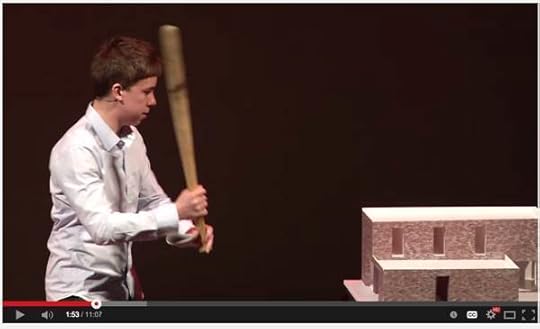
Kasper Bormans demonstrating what happens to a brain suffering from Alzheimer’s disease. Notice the Memory Palace allusion.
However, as the disease progresses, patients experience more long-term memory loss and deficits, including erosion of episodic and semantic memory.
Patients with Alzheimer’s disease may have difficulty identifying objects or finding words to describe something. They may also suffer from impairments in their ability to recall significant events, such as weddings.
Other types of dementia can also affect short-term memory and long-term memory. For instance, a person with dementia of Alzheimer’s type can find it difficult to store information in the long-term memory, and also can have challenges with retrieval.
Any damage to the medial temporal lobe that plays a critical role in acquiring and retrieving both semantic and episodic memories can also affect your semantic memory.
Studies have also been done on different effects that semantic dementia and herpes simplex virus encephalitis has on semantic memory (Lambon, Lowe, & Rogers, 2007). The study revealed that semantic dementia has a more generalized semantic impairment.

Moreover, amnesic patients also have great difficulty in retaining episodic and semantic information.
Your semantic memory function also is extremely susceptible to cerebral aging and neurodegenerative diseases.
A neuropsychological evaluation can reveal how your brain functions. Neuropsychologists use neuropsychological tests to characterize behavioral and cognitive changes resulting from disorders of the central nervous system or injury, like Parkinson’s disease or other movement disorders.
While you may not be able to protect your memory from all types of diseases, there are ways to improve your memory so that it doesn’t fall victim to age-related memory loss or dementia.
But don’t worry. As Nic Castle found, it’s possible to recover, even from ailments like PTSD.
How to Improve Semantic Memory?
Here are 3 simple ways to improve your semantic memory:
1. Magnetic Memory Method
The easiest and most powerful way to improve your semantic memory, as well as episodic memory, is by learning how to build Memory Palaces using the Magnetic Memory Method.

The Magnetic Memory Method Memory Palace approach is better for remembering and learning than something like mind mapping on its own.
It is an incredible combination of intelligence and memory strengthening tool. Combined with Recall Rehearsal, this holistic process lets you move information from short-term memory into long-term memory faster and with reliable permanence.
What’s more?
You can use all other memory methods inside of Memory Palace, however, you cannot use a Memory Palace inside other memory techniques. This unique approach maximizes the power of the loci method and combines nicely with the pegword method.
All that matters is that you don’t overthink the technique. We all learn it by doing it.
2. Exercise Your Brain
It is essential.
Exercising your brain regularly is the most effective strategy to improve memory and retention.
Memory impairment or memory loss in older adults is common. However, there is a strong relationship between brain exercises and improved cognition and retrieval in older adults.

Numerous tools and exercises can help you to assess your memory and enhance it through games and training exercises. It is a known fact that the more you utilize your neural circuit, the stronger it will get.
This fact can also be applied to numerous neural networks associated with contextual memory, auditory memory, visual memory, short-term memory, working memory, naming, and more.
You can improve your skill of identifying the right word to use for a concept or an object by training the neural network in your brain accordingly.
Here’s a video that will inspire you to use memory techniques and treat them as the ultimate brain exercise.
Brain Games [Memory Improvement Inspiration!]
3. Learn a New Language
When you learn a new language, it requires you to learn and expand new sentence structures, grammar rules, and vocabulary.
Such activities ensure that your semantic memory is continuously being utilized and strengthened as you make progress with the new language.
Here’s a video that helps you learn and memorize the vocabulary of any language.
Learn The Vocabulary of Any Language
Higher Attentiveness = Improved Memory
Your relationship with the world around you is dependent on your ability to learn and recall factual knowledge accurately.
Being mindful of the things around you and paying attention when you come across new information is essential to creating long-term memories that can be recalled when necessary.
When you practice mindfulness in everyday activities, you are more attentive. Attentiveness, in turn, helps you encode information better in semantic memory.
Moreover, when you combine attentiveness with the Memory Palace method, your ability to retain and recall factual knowledge is stronger and faster.
If you are interested in the Memory Palace method, please don’t hesitate to get started. I want to help!
Now then, time for a quick test of your semantic memory:
Can you recall the name of the character in the novel I mentioned near the start of this article?
You could, if only you devoted yourself to more memory training. Ready to get started?
The post Semantic Memory: An Example-Driven Definition And How To Improve It appeared first on Magnetic Memory Method - How to Memorize With A Memory Palace.
September 5, 2019
How To Stop Overthinking The Memory Palace Technique
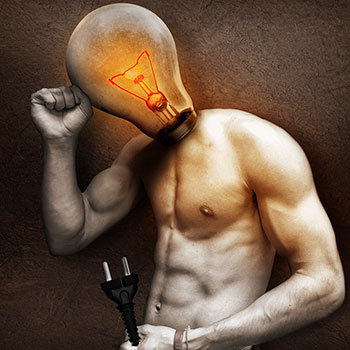 Are you overthinking the Memory Palace technique?
Are you overthinking the Memory Palace technique?
If so, you’re interrupting your progress.
Worse, you’re delaying your ability to memorize information at lightning speed.
And no memory expert or memory champion wants that for you. That’s why we all keep working so hard for you to share in the miracle of life after you have the tools for memorizing anything.
On this page, I want to help you get out of the “analysis paralysis” problem.
If you take the right steps without getting caught in mental sand traps, I’m confident you can develop your first Memory Palace Network quickly and easily. If not, you risk having a skull that is still spinning its gears, having missed out on so much fun and adventure.

Ethical “scare tactics” aside, here’s another reason to read this page in full:
I want to help you escape overthinking overall. Having the tools to feel that something is complex and do it anyway is important because too much thinking has been proven to carry many ill effects.
The truth:
Thinking is involved in using the Loci Method, no doubt about it. But thinking without overthinking is achievable, and today you’ll learn precisely how.
How To Defeat The Over-thinker By Becoming A Mnemonic Mechanic
The first problem with overthinking is how it slows you down.
For example, imagine walking into a business meeting.
You meet three potential investors. , on the spot is pretty important, wouldn’t you say?
Well, you don’t have the luxury of time to overthink the situation.

Instead, you need a system in place so you can deal with those three names, without thinking about the technique to be able to memorize them. Everything should happen (almost) on autopilot. You just plug those names into your system and recall them effortlessly on demand.
Consider the mechanic and his toolbox.
A mechanic is so familiar with the contents of his toolbox that he knows exactly what he needs for each job. He knows which tool can perform which function and in which instance he would use each one. He just knows when he needs a 10mm socket or a flathead vs. a Philips screwdriver.
Memory techniques can be these tools in the toolbox of your mind. What’s the key to the mechanic’s innate knowing?
Two words:
Preparation and practice.
Prepare Your “Mental Lego” Before You Need It
The speed of making associations in your Memory Palaces comes from not having to think about the technique and how it works.
How is this possible?
Easy:
The “thinking” part is already done before you need to use any of the tools. Your “in the moment” thinking is minimal.
It’s just like being a mechanic who has the right tools in the toolbox so he can perform the job onsite without a passing thought.
So, what are the tools you need? If nothing else, I suggest you develop:
A Memory Palace Network
At least one alphabet list/celebrity list
The Major Method/Major System
Think of the Memory Palace as a foundational field. The “Magnetic Imagery” of your lists and systems are the “Mental Logo” that you plug into place.
For example, if you meet someone named Rose and you put Axel Rose on her shoulder, Rose is the Memory Palace and Axl Rose is the Mental Logo.
If you have Axl Rose doing something memorable using the Magnetic Modes, then he becomes a Magnetic Image.
When you have these three components ready to go and practiced, you’ll be prepared to perform, every time the need arises.
Let’s look further at each tool.
How To Master The Memory Palace
The Memory Palace, like a hammer, is the most basic of tools. Every toolbox has a hammer. Every memory technique arsenal has a Memory Palace Network.
What is this network?
26 Memory Palaces, one based on each letter of the alphabet. Would you like some videos and worksheets that walk you through how to develop this powerful system?
Mastery of the technique seems to occur about halfway between creating all 26 and filling each with approximately 10 pieces of information each.
Anything less just isn’t leading you to the “Magnetic” effect I have in mind for you.
Skeptical about this techniques? No worries. Here’s the science behind why this memory technique works so well.
Enter The Alphabet List
Some people may call the alphabet list by another name, such a celebrity list, bestiary or “sun list.” No matter what you call it, the principle is generally the same.
An alphabet list is simple a list of figures that you’re able to draw upon that you have figured out in advance. It’s not unlike one of the four pegword systems out there.
Your Memory Palace Network can help to generate your alphabet list. Here’s how:
If you have one Memory Palace with 26 Magnetic Stations, place one Magnetic Image on each station in alphabetical order.
Remember Axl Rose?
He’s a perfect ‘A’ figure for station one of this Memory Palace.
How about Bill Murray for ‘B’? Christian Bale for C?
(Now, I know what you might be thinking:
“Didn’t he just use Axl Rose for Rose? Is he an ‘A’ or an ‘R’?!?”
My friend, I’d be dumbing this down too much if I didn’t tell you the truth:
Every Magnetic Image with a first and last name can be both. Is that too hard to grasp?
If so, I suggest you catch yourself, because it really isn’t that difficult. Every shoe lace is one shoe lace, but we still make two ears to tie a single bow, if you catch my drift.)

Go ahead and try this by simply writing out A-Z on a sheet of paper and filling in 26 celebrities.
Seriously:
Just get a pencil and some paper and make it happen.
Then, the next time you have to memorize something, look at the first letter of the information and use your “Magnetic Image” to help you.

This simple Celebrity List took 2.5 minutes to create. In medieval times, mnemonists called this technique the “Bestiary” and would have used primarily animals that symbolized concepts with which they were deeply familiar.
For example, I memorized a Chinese word yesterday that had ‘Z’ for the first syllable and ‘G’ for the second. I saw Zorro playing Sega Genesis, guided by several of my lists.
Should you create several lists?
Yes! Having more than one list is essential if you want to become a human mnemonics dictionary (recommended).
But there’s a catch:
Although you want fixed references that you draw upon, you also want flexibility.
For example, I might meet someone name Rose, but perhaps Axl Rose won’t appear that day (for whatever reason).
For that reason, I’ll want to be able to spontaneously come up with another, equally powerful version option.
How?
By practicing creating lists. That’s what makes it easy to come up with mnemonic examples spontaneously when something from your lists doesn’t appear.
Why The Major System Simplifies Everything
(Even If It Appears Difficult At First)
Let me be blunt:
Everyone needs a technique in place for number memorization.
Although the Dominic System is a strong option, I’ve always preferred the Major.
In case you’re not familiar with these terms, both help you transform numbers into sounds that you can turn into words. The grid you need to memorize is this:

Once you’ve got this in your mind, it takes just a bit of practice to spontaneously generate words for numbers.
For example, I might think of “chuck” when I need to remember the number 67.
However, remember the principle of preparation.
As with the alphabet list, it’s far better to have all of your possible characters ready in advance.
A list based on either the Major System or the Dominic System is often called a 00-99 list or a P.A.O. (Person, Action, Object.)
This is where you might think…
I thought you told me not to overcomplicate this process!
And you’d be right, which is why I suggest beginners focus only on the grid listed above in the beginning. I used it with no problems for a few years before assigning a character to each two-digit number combination.
It takes four minutes to memorize if you just notice a few things about each association:
D and T both have a single downstroke that looks like the digit 1.
N has two downstrokes, and Noah took the animals onto the ark in pairs.
M has three downstrokes, and looks like a mustache or McDonalds logo on its side.
R looks kind of like a rounded 4, but it’s facing the wrong direction.
L is exactly the shape you’ll see your left hand thumb and forefinger make if you hold it out in front of you.
Ships kind of look like the number 6 if they’re tipped on their side… especially if they’re hauling jars filled with chip.
K is kind of like two 7s lying on top of each other.
F and V are produced by making the same basic shape with your lips. Go “vroom” for a few minutes while thinking about a V8 engine.
B and P either contain or look pretty much like the number 9.
Don’t make it more complicated than this – because it isn’t.
Practice until you’ve got it down pat and then start listing your words. Here are some tips for that:
Next, practice memorizing real world numbers:
Go to the store and memorize the prices of the items you see.
Commit historical dates of movies to memory, or even the release dates of your favorite artist’s discography.
Whatever numbers are important and applicable to your life, make those your learning goal. Use these Memory Palace examples to help you understand how to store the imagery.
Practice Makes Progress
Once you have your tools in place, what next?
Easy:
You must practice “snapping” your Mental Lego together. Your Magnetic Imagery has been doubled checked and organized. All the heavy lifting is done.

But seriously, where do you start?
Here’s what I suggest:
Names are the most essential information on the planet.
Why?
Because every piece of information, every item, every action and every place is assigned a name.
Even better:
There are several low-pressure, low-stress memory exercises that let you practice name memorization.
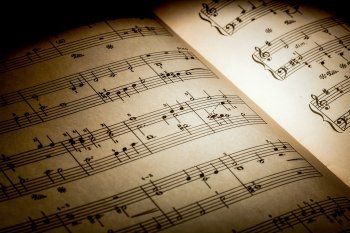
Try this:
Go through your CDs at home, or your records, or your tapes, if you still have tapes, and then think “Do I know every member in this band?” If not, practice with these names in the comfort of your living room.
If you like movies, you can work with movies.
For example, you can go through movie collection and think “Okay, what are the directors of these movies?”
What’s important about these kinds of practices is they’re all low stress. You’re not going into a room and memorizing a bunch of names and only stressing yourself out.
But when you’re ready for the challenge, go into restaurants and memorize the names of staff members. If you make a mistake, don’t worry about. They’ll forget all about it and you can analyze what went wrong with your Magnetic Imagery and Memory Palace strategy.
The Power Of Practicing With Vocabulary and Phrases
Once you have a firm grasp of names, you can practice vocabulary and phrases.
You can either search out a Random Name Generator on Google, or take the exercise analog with a real dictionary if you want to avoid digital amnesia.

For phrases, this is where a larger memorization project comes in. Is there a particular famous speech you want to memorize, a poem, or other text? Break the entire piece down, phrase by phrase, and apply your memorization tools to this exercise.
Why This Time Commitment Pays Huge Dividends
You might be asking, “How long should all of this take?”
It’s an okay question, but not the best one.
The reality is that only you hold the answer for how long memory mastery will take. After all, your definition of “good” may differ wildly from another person’s, depending on how laid back your practice is, or how many perfectionist tendencies you possess.
But let me be direct based on nearly a decade of teaching these skills:
On average, within two to five hours, most people have all of the tools we’ve talked about on this page covered.
Compared to other fields, this is only the amount of time it would take to:
Run a marathon.
Cook a stellar three course meal.
Assemble a dresser from Ikea.
Isn’t your memory worth this truly insignificant amount of time?
Sure, it’s a couple of hours. But that’s not a huge time commitment considering the lifelong value you get out of the tools.
Plus, the development of your systems is as important as the systems themselves. It really all comes down to finding a starting point.
The Secret To Just Getting Started
If you don’t know where to start, you need to come up with a learning goal. What is it you would like to achieve? What would you like to accomplish? If you can figure that out, then the starting point will become clear.
Here are some further tips on setting goals and crafting a Magnetic Vision Statement:
Take the time to set a proper course, and you will be rewarded with focus.
But don’t just settle for goals.
Build the systems that enable you to make steady progress towards accomplishing those goals. It’s about bringing vision and step-by-step planning together. Speaking of which, here are…
Your Next Steps
Once you have your starting point and the desire for creating your own systems, complete your first Memory Palace and Celebrity List. As we discussed, your Memory Palace will help you to memorize all the other tools. Consider developing these tools both the first and most important step.
With these tools in place your next step is to choose a meaningful learning project.
My suggestion:
Learn and practice these memory tools with something that will improve your life:
What will lead to a promotion at your job?
What doors will learning a new language open for you?
What skills can you learn that will truly transform your life?
In sum, you will learn way more by doing and reflecting, than just overthinking the process in advance.
Think of it this way:
If you are tasked with walking a mile, what is the only thing that causes you to travel that distance?
Putting one foot in front of the other.
Listen:
Don’t stress yourself out over these techniques.
And don’t let your need for “success” stop you from taking action.
Need a “guaranteed” outcome is the biggest flaw of overthinking. It’s the worst kind of overthinking and leads far too many people to a standstill. Overthinking leads paralysis analysis, which is like being caught by the dark side.
And that is something we should all use the “force” of memory to resist.
The post How To Stop Overthinking The Memory Palace Technique appeared first on Magnetic Memory Method - How to Memorize With A Memory Palace.
August 22, 2019
Loci Method: 9 PRACTICAL Memory Palace Practice Tips
 Are you intimidated by the idea of building your own Memory Palace using the loci method?
Are you intimidated by the idea of building your own Memory Palace using the loci method?
After all, the word “palace” brings to mind an elaborate dwelling.
It’s huge.
And complicated, right?
It doesn’t have to be that way.
Just think of the phrase “Memory Palace” or “Mind Palace” as a name that helps you cherish the knowledge you put into it. It’s not really about the place itself.
And the term “loci method” really just means that we’re turning space itself into a mnemonic device. I think of this memory tool as a “location-based mnemonic.”
Personally, whenever I get stuck on how to best use the technique, I mind map out as many method of loci examples as I can.
But on this page, I want to go further.
I want to help you learn the loci method well and build your first Memory Palace Network in a way that is completely stress-free.
That’s why I’ve put together these nine practical tips that will help you practice the technique once you’ve learned it.
Let’s dive in.
#1: Learn To Use The Loci Method Simply
This means exactly what you think.
No clickbait here. Just keep it simple.
Don’t overcomplicate or overthink the Memory Palace technique.
It’s easy to overthink and analyze, of course. It’s in our nature, right? Well, we can still scrub it out. Here’s some help:
#2: Add Complexity As Your Skills Grow
Just because we want to keep things simple, doesn’t mean we’re going to stand still.
Although you use of the method of loci should be simple in the beginning, naturally adding complexity as your skills grow is important.
For example, your first simple Memory Palace of your childhood bedroom can grow to include:
Your entire home
Your block
The walk to school
The drive to work
Churches, cafes, art galleries
Other Memory Palace examples
But before you expand, you’ve got to get good with just one Memory Palace.

That means starting with your existing competence. Don’t overcomplicate things.
With practice you will see that there are some places where simplicity will always rule and complexity is not desirable.
Ever heard of the phrase, “Just because you can, doesn’t mean you should?”
That’s a great rule of thumb to keep in mind when using this memory method.
#3: Use Different Sized Journeys
Once you have grown your practice to where you have built several Memory Palaces, you’ll want to have a way of linking them together, right? This is where the Method of Loci, or journey method comes in.
Consider this:
You’re planning a road trip to a big music festival several hours away.
You can take several routes to get there.
You want to get there as quickly as possible, to get your tent set up, your campsite secure, so you won’t miss any of the bands on the lineup. You’re not wasting any time between loading up your car and pulling up to the front gate.
Then on the way back you need some time to decompress. You’ve spent four days in a field, listening to the biggest names in music from sun up to well past sundown. You’re not in a hurry to get back to the “real world.”
You take the scenic route home, stopping at greasy spoon diners and tourist traps along the way. You make a game of it by telling Google Maps to “avoid highways” even.
Both these routes got you from point A to point B (or B to A as the case may be) but they were significantly different. They had a different purpose. Think of your journeys linking your memory palaces in this same way. You have shorter and longer journeys, more complex and simpler journeys, all to serve you differently.
#4: Use White Space
“Less is more.”
While it can be useful to have very condensed Memory Palaces, and those memory palaces can be filled and overloaded with tons of stations, it can also be very beneficial to see what happens when you have less. Try working in a manner that’s spaced out, instead of overloaded.
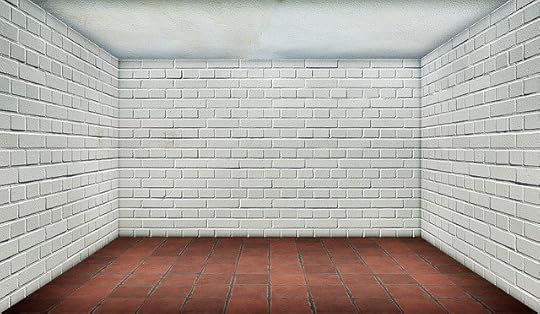
You can apply this idea to not only your Memory Palaces, but what you encode in them. Memorize less, encode less, and see if you’re able to have more recall from focusing on fewer pieces of information.
The goal is to avoid the “Dr. Faust effect.”
The legend of Faust warns us against a downfall caused by a greed for all knowledge. He was unsatisfied with a mastery, law, logic, science and theology, and turned to the dark arts, where he eventually was damned as he sold his soul to Mephistopheles.
Instead of just collecting information, never satiated, why not be satisfied with the big ideas, having an appreciation of the white space? You’ll find that your mind actually will fill in the blanks and you don’t need that overload of information. The white space will take care of itself.
#5: Complete Both Short Term And Long Term Projects
To keep your practice fresh, have both short and long term projects you are working towards.
A classic short term project is to have a daily run through of memorizing playing cards. Keep a deck handy (maybe beside your coffee pot in the morning, or near your reading nook) so you can shuffle and memorize a handful in your downtime.
For a longer term project, this may be learning a new language or memorizing a collection of poetry.
Toggling these two projects will keep you from becoming bored and burnt out with a singular goal.
#6: Explore Indoor vs. Outdoor Memory Palace Options
As you move toggle between short and long term projects, explore using indoor and outdoor Memory Palaces for your memory journeys.
As an alternative to viewing your memory tools as simply one large Memory Palace, what if you thought of it as a collection of smaller memory palaces?
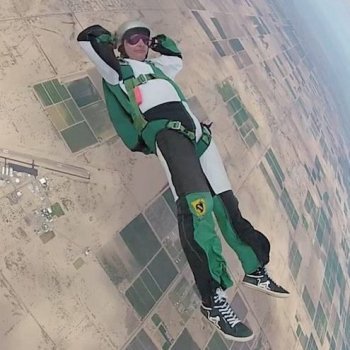
Okay, Kevin… Not that far outside!
For example, a home is a collection of room, a room a collection of areas and corners. A park can be seen as a playground area, hiking trail, community pool.
(Or you can skydive and wander your Memory Palaces like Kevin Richardson does while using Recall Rehearsal for learning Japanese with mnemonics.)
Be flexible and bring a sense of playfulness to creating your Memory Palaces. They will be far more beneficial as living and growing entities instead of a static, fixed creation.
For more on outdoor Memory Palaces, check out my discussion with Lynne Kelly on the craft of memory.
#7: Understand That Memory Pales Are Pegs To Which You Can Add Pegs
Think of your Memory Palaces as pegs to which you can add pegs, or spaces to which you can add pegs.
When people first get started with memory techniques they may see these tools as mutually exclusive, instead of elements that can be used in partnership.
Yet, the Peg System works exactly how you would imagine, pegging or linking one thing to another. Building upon what you do know, you connect the new information to it in your mind.
(No, peg system is not that different from the pegword method, but it’s worth exploring both.)
#8: Persist with S.I.P.
Now even though I’ve broken down mastery of the Method of Loci down to nine simple tips, it may not always be easy peasy. You will be faced with challenges along the way. There’s just no getting around it. Success with these methods is not about not having those setbacks, but that you know how to deal with them.
And one of the best ways to deal with those challenges is to make sure you have a good library of memory training.
Use all of the information you have available to you. Utilize it constantly and consistently. Take S.I.P. to heart:
S = Study the techniques for yourself consistently over time
I = Implement what you learn from you study of memory techniques and its tradition.
P = Practice these techniques with information that improves your life.
Be ever vigilant in tweaking your practice and improving it. As Nicholas Castle found, this practice can release you from some big problems in life, as it did with his PTSD.
#9: Keep A Memory Journal
Finally, keep a memory journal. It is crucial to have a place, a record of what you’re doing, how you’re doing it. Only then are you able to proceed and know where you’re going if you know where you’ve come from.
Although you could use something like Evernote for better memory journaling, I personally don’t see the attraction.
Instead, consider going back to “keep it simple.”

And if you’re feeling overwhelmed, just start with just one of the tips on this page.
See how implementing it improves the ease and speed of which you can create memory palaces and progress through the Method of Loci.
Mix and match these principles to maximize your efforts and you’ll see just how effortless the process can be with practice over time. Then move on to these more advanced Memory Palaces training exercises.
The post Loci Method: 9 PRACTICAL Memory Palace Practice Tips appeared first on Magnetic Memory Method - How to Memorize With A Memory Palace.
August 15, 2019
Scott Young On “Ultralearning” In Your Self-Directed Education Journey
 You’ve probably spent time in your educational career feeling frustrated, right?
You’ve probably spent time in your educational career feeling frustrated, right?
You know the routine:
It’s the night before a test, and instead of resting…
You’re “cramming” to try to remember the things that didn’t quite stick during a lecture.
Here’s the thing.
It’s not your fault.
And there truly is a better way to learn.
No, it’s not sitting and listening to a professor, reading or copying from a textbook, conversing with a language learning partner, or mindlessly practicing yet another skill suggested by a learning “guru”.
To help explain what really works, my guest today on the Magnetic Memory Method Podcast is Scott Young, author of the new book, Ultralearning.

In this book, Scott shares the stories of people like language learner Benny Lewis, Eric Barone, World Championships of Public Speaking finalist Tristan De Montebello, and the French Scrabble world champion Nigel Richards.
These are people just like you. The only difference is they’ve discovered a better way to learn, through “aggressive,” self-directed learning.
Today’s conversation with Scott not only explores the concept of “ultralearning,” but Scott shares his own efforts to learn more, better, and faster.
To be frank, a lot of involves simply directing your energy towards what works. Isn’t that better than spending years trying to fit into a traditional learning model that may not work for you?
So, if you’ve ever struggled to learn a new language through books alone…
If you’ve sat in a classroom only watching a professor demonstrate a chemistry experiment and not been able to “get it” because you lacked hands on experience…
If you’ve used trial and error to make the perfect recipe and still ended up with a soupy mess for pancakes or an overly salty roasted chicken…
Ultralearning can be the breakthrough you’re looking for to finally discover what really works for you to achieve you learning goals.
Press play now and learn all about:
The definition of ultralearning and the origin of the term
The difference between autodidacticism and ultralearning
Why self-education is not always the best choice for effective and efficient learning
The importance of being a skeptic while being a reader
Why we really don’t know what we’re truly capable of…we’re actually shortchanging ourselves
How ultralearning can be masochistic, yet beneficial
Why you should actually care about the act of learning
Why self-testing and feedback are necessary, even with self-directed learning
The role of free will in education
What meaningful progress looks like in achieving your learning goals
The difference between procedural and declarative memory
How and when mnemonics are useful
Overcoming challenges with consistency in a learning practice
Contrasting the traditional work model and entrepreneurship (pros and cons of each)
When it comes to consistency in scheduling, Scott is also tremendously generous in sharing how he schedules his time. Check this out:
So you see?
It’s really not so hard.
Does Ultralearning Get My Thumbs Up?

You bet!
I’ve actually been reading Scott’s emails for a long time and even sought out his okay to hold this live stream walkthrough of a piece on his blog about critical thinking:
I hope he and I will have a chat to discuss the role of critical thinking in learning more in the future. But for now…
Don’t miss this book and make sure you follow Scott Young!
Further Resources on the Web, this podcast, and the MMM Blog:
Scott’s interview with The Leefkoe Institute
21 Study Tips on MagneticMemoryMethod.com
Brain Exercise Apps: Do They Help or Hinder Cognitive Development?
The post Scott Young On “Ultralearning” In Your Self-Directed Education Journey appeared first on Magnetic Memory Method - How to Memorize With A Memory Palace.
August 7, 2019
Memory Craft: Lynne Kelly On The Potent Power Of Ancient Mnemonics
 It only took three pages for Memory Craft to become my favorite book on the art of memory.
It only took three pages for Memory Craft to become my favorite book on the art of memory.
Why?
The answer is simple:
Lynne Kelly, the author of Memory Craft, is devoted to helping people memorize information that matters.
And in a world cramped with endless memory improvement books devoted to directing memory skills at insignificant trivia, Memory Craft is a breath of fresh air.
Here’s why:
Memory Craft concentrates on learning facts, languages and processes real people can use in every day life (like using the multiplication table directly from memory). She also addresses memory science and how these techniques can be used by young people.
Now, you may remember Lynne Kelly from a previous interview where we discussed her fantastic book, The Memory Code.
I’m thrilled to have her return to The Magnetic Memory Method Podcast to talk about her newest release. The full title is: Memory Craft: Improve Your Memory Using the Most Powerful Methods From Around the World.
For those of you not familiar with Lynne, here’s the lowdown:
Not only is Lynne Kelly the author of several books on memory, but she is a highly skilled researcher, science educator, author and memory competitor.

Most known for her theory about Stonehenge’s purpose, she has also contributed to work in popular science and is a promoter of skepticism.
Lynne’s critical thinking and contributions to such a wide range of science subjects has led to awards from the Royal Zoological Society of South Wales among others. As a memory expert, Lynne Kelly is that rare practitioner who takes on large learning projects and shares the journey in addition to attending memory sport activities.
And that’s what makes today’s conversation with Lynne so special. Lynne helps us explore our need as a species to treat our minds as “muscles” that deserve ongoing development, ideally through a combination of learning and play.
Using tested memory techniques for completing fun and engaging memorization tasks, Lynne traces the timeline of the important role these skills have placed from ancient times to today’s memory competitors.
As a unique book on accelerated learning techniques, you’ll discover visual alphabets, medieval bestiaries, indigenous learning systems, and modern card memorization as Lynne has explored and updated them for citizens of the modern world.
If you want to learn a foreign language, you need to memorize and deliver a speech, or you’re a student preparing for an exam Lynne has a solution for your memory dilemma. The best part?
Lynne’s suggestions for incorporating mental exercise into your daily routines work even if you only have 5 minutes a day.
Intrigued? Press play above and you’ll discover:
* The real reason why stores play such upbeat, catchy music.
* Why outdoor Memory Palaces can be so helpful for memory retention.
* The benefits of “setting aside” time for memory training versus incorporating practice into everyday life.
* How vivid, violent, or vulgar imagery can bring abstract concepts to life.
* Why “rapscallions” are useful memory tools and not just mischievous little creatures.
* How art can help you remember more in a Memory Palace.
* The pros and cons to living with aphantasia.
* The key to using hooks and layering to create dynamic visuals.
 * How to “dialogue” with your memory aids.
* How to “dialogue” with your memory aids.
* Why we should encode using music and places for maximum mental skill (and possible mental health) benefits.
* The usefulness of memory techniques for school aged children and their long-term effects.
* The secret to overcoming “ghosting” when using memory techniques.
Further Resources on the Web, This Podcast, and the MMM Blog:
Lynne Kelly (The Memory Whisperer)
Lynne Kelly’s TEDxMelbourne Talk
The post Memory Craft: Lynne Kelly On The Potent Power Of Ancient Mnemonics appeared first on Magnetic Memory Method - How to Memorize With A Memory Palace.
July 31, 2019
9 Awesome Accelerated Learning Techniques [Beyond Mnemonics]
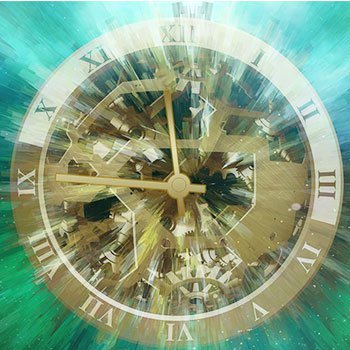 Do accelerated learning techniques really speed up learning?
Do accelerated learning techniques really speed up learning?
Well, if you’re looking for ways to maximize your study sessions and get the most “bang for your buck,” here’s the real deal:
Most of the shortcuts people associate with “speed learning” and “speed reading” actually make things longer and harder.
That’s right:
Speed reading is not a shortcut!
(This is because most people can neither comprehend nor remember when they’re skimming like a maniac.)
But if you want a collection of techniques that will truly accelerate your learning process and help you master your discipline in a shorter amount of time, then it really does need to be just that:
A collection.
And to be clear:
Learning “faster” isn’t always about efficiency.
In fact, the fantasy of efficiency throws up one of the biggest barriers around. People waste time trying to master shortcuts that are never going to work.
Why?
Because they haven’t mastered the fundamentals that allow the learner to even understand the shortcuts, let alone effectively use them.
And that’s why we’re going to start this training by busting some of the myths around learning techniques that some self-proclaimed learning gurus (strangely) vilify:
Highlighting
Re-reading
Keyword notes
We’ll cover when and why these 3 techniques can actually be great, and then explore 6 of the classic accelerated learning techniques everyone should know.
What Makes A Learning Technique “Accelerated”
I don’t know about you, but I’ve personally found highlighting and re-reading to be very helpful.
But there is definitely a right and a wrong way to perform these strategies.
In fact, they are deeply problematic if you don’t take into account what matters:
Context and strategy.
(Especially with respect to effective note taking techniques.)
Whenever evaluating a learning technique, ask yourself important questions like, “What context am I in?” and “Does this apply to what I’m learning?”
Take into account your desired outcome and the application of strategy in context.
Use A Mind Map And Vision Statement To Help
Literally map out what you want to achieve and see how relevant a learning strategy is to that goal. I suggest you use Tony Buzan’s Mind Map Mastery to help.
I also suggest you create a vision statement. Here’s how:
Then, analyze your results with the technique you implement into your study sessions. It literally requires some trial and error before you pass final judgment on what works in different contexts.
Finally, you must be willing to conduct experimentation to improve your results. Don’t be afraid of making mistakes while searching for what works best for you. There is no end all, be all when it comes to study techniques.
It doesn’t matter what others say. Highlighting can be useful in context, and I’ll explain why. Re-reading can be a great strategy for learning. Keyword notes can be extremely beneficial to achieve your desired outcome.
My advice? Don’t listen to the critics who dismiss these techniques so easily…instead let’s explore them a bit more in depth.
3 Bad Learning Techniques Made Good (In The Right Contexts)

Sensible Highlighting
Highlighting can be useful for names, dates, key terms, and definitions.
Why is it a useful technique?
Certainly not because it helps you concentrate better while reading a text. After all, no matter how much you refine the approach, you’re still stopping and starting the reading process.
Nonetheless, the benefit of highlighting’s usefulness is rooted in delayed benefits.
For example, when you return to the text you can rapidly flip through the pages and say:
“That’s information I need.”
You don’t get the results immediately, but in context, the benefits can be powerful.
Used in a sparse and targeted manner, highlighting is a great alternative to having to search for specific kinds of information.
What kinds of information? When I was in university, I used highlighting for creating “beacons” that helped me rapidly gather:
Names of people
Dates
Key terms and definitions
I identified them on the first read, and then circled back to pick them up for memorization later.
Color Coded Highlights?
Should you experiment with color coding your highlighting?
If it helps you rapidly distinguish names from dates, why not? I’ve personally never found pausing to change colors worth the time, but you might.
For me, I limit this technique to specific “seek and find” tasks. Highlighting in just one color – sparingly – is the best strategy when I don’t mind marking up my books.
Alternatives to Highlighting
There are alternatives to highlighting as well. These are tidier and a bit easier on the eyes than a sea of neon in your text.
For example, try something I’ve coined the Marginalia Dot, a simple dot in the margins.
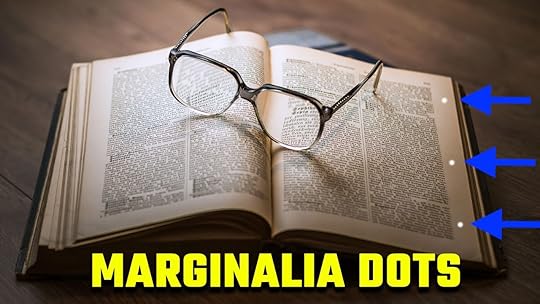
You can also use squares, circles, using brackets, or underlining in a text.
Develop your own system so you can discover what works best for you. Only you can, so dive in!
Re-Reading
I’m no stranger to re-reading a text, as you know.
Personally, I feel that re-reading is always a good idea after pre-reading and priming as well as after reading a book, and even after note gathering and memorization.
Now, I know that one of the reasons why re-reading is frowned upon is not because of the effectiveness of the technique itself.
It’s user error.
People have just not thought to budget and schedule the time for re-reading. The key is to set aside the time, instead of blaming time for being what it is.
Keyword Notes
While the precise definition of “keyword notes” varies from person to person, it generally just means boiling bigger ideas down into individual words that help us unlock the larger concept.
For example, on this mind map, I boiled down an entire concept related to practice down to just that keyword, even though multiple ideas were involved.
Not madness like this early mind map I created (though this approach was not entirely for nothing):

A problem that many learners face is that they just don’t know what keywords they should use to unlock the larger concepts.
The best way to gain clarity? Ask.
Ask your professor, ask other students, or even the department secretary. Ask for copies of previous exams, or explore related texts by using indexes, bibliographies and online search tools suggested by librarians.
You must become a bit of a self-directed detective. Learn to ask the “right” questions by just getting started with asking them.
Also, here’s a next-level mindset tip: Let go of the idea that you could ever know everything there is to know. We are all constantly learning. We are lifetime learners, constantly searching out “keywords.” Accept this fact and enjoy the ride.
What Makes The “Good Accelerated Learning Techniques” Coming Up So Good?…
If highlighting, re-reading, and keyword notes are bad, what makes an accelerated learning technique good?
The same things that make the bad, bad! (Mind-blowing, I know.)
Remember, it’s not so much about the techniques, as it is the strategic deployment of the right technique in the right context.
When it comes to the classic accelerated learning techniques, let’s explore more of the details that will help you choose based on the learning situations you find yourself in.
Self-Explanation
There are many ways to practice self-explanation, such as the Feynman technique:
Another method is to perform regular progress checks. Here’s how:
Record and analyze your progress. You don’t have to be hard on yourself if you don’t see a rapid improvement or something you believe is measurable, but really invest the time to explore where you are at with your learning journey.
For related tips like these, please see:
How to Create An UNSHAKABLE Memory Palace Training Routine
Take Practice Tests
Whether they be in textbooks, online, or are previous tests from your department of study, there are practice tests widely available for you to utilize if you seek them out.
Once you take the time to find “where you’re at,” and know what needs improvement in your knowledgebase, fill in the gaps with some “brute force learning.”
Although this accelerated learning term sounds like cramming, it isn’t.
Instead, putting on a timer and gobbling up as much related information as you can helps foster better understanding. It’s a powerful alternative to saying “I don’t understand.”
Instead, you tell yourself “I’m going to understand this. This is not something that I get right now, but I’m going to write out what it is I don’t get, and then I’m going to craft a plan that helps me seal the gaps.”
In this way, you are taking charge of your education through self-explanation and a little tough love. So the next time you get hung up on something, journal the nature of the problem and then write out the most likely way to solve it.
Like this:
“I don’t understand this concept about nuclear fission. My book defines it as ______________. What I don’t understand specifically is _____________. To help myself understand, I’m going to search the key terms on Wikipedia, YouTube and try to find a few blog posts from experts on Google.”
Isn’t a small bit of time spent in self-explanation better than giving up?
Elaboration
Elaboration is a mental process where you repeatedly ask yourself the classic questions of “Who, what, where, when, why, and how?”
Instead of just reading a text, this approach allows you to dig into it contextually. It’s essentially a means of manually injecting curiosity into your learning process.

For example, when dealing with mathematical formulas (for example) you can ask:
Who came up with this?
What were they doing with it?
When did they come up with it?
Where were they when they came up with it?
Why did they come up with it?
How exactly did they come up with it?
Really engage in the mental process of doing more than reading, but exploring, through questioning, the context.
Historical context can be very important!
The more you look at historical contexts, the more you’re able to compound a variety of levels of information. This act is itself a memory aid because you create more mental connections while doing it.
You’ll also want to use tools of comparison and contrast. Compare things historically, geographically, and geo-historically.
The possibilities are infinite. Use the power of combining multiple levels with these simple questions to your advantage.
The Power Of Consequences
Finally, take into consideration consequences of things which are always important to know.
For example, you can ask: “For those who understand the consequences of this knowledge, what happens for them as a result?”
Albeit conceptual, this is yet another layer of information that can deeply bolster your understanding and instantly make things more memorable.
At the end of the day it all comes down to getting granular with the text and diving deeper than a surface level of engagement so common amongst those who read passively.
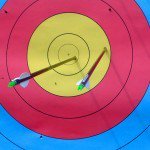
Proper Goal Setting
You must have a purpose and a why to what you’re doing. Too many times young people are pushed into making major life decisions at a very early age. Even if these people do become successful, they often wind up wearing golden handcuffs.
What exactly are golden handcuffs?
Golden handcuffs chain your life when you’re successful in completing goals, but you wind up miserable because you’ve led yourself into a career that is very different from what you wanted to do.
For example, how many highly successful doctors or lawyers had childhood dreams of becoming artists or musicians? What about the corporate executive who really wanted to be an author when he or she grew up?
At surface level they have it all figured out and should be happy. But we all know how it goes. In reality, so many people who seem successful are actually unfulfilled. And sometimes, accelerated learning techniques helped lead them into the maze that traps them.
How can this be avoided?
Easy: Proper goal setting.
Set goals that:
You can actually accomplish
You actually want the outcome of,
Help you grow
Give you options beyond the outcome so that you’re able to go in different directions after you’ve accomplished a certain level of goal.
Many people set goals that require smaller goals on the way to a larger goal, like stepping stones.
The smaller goals build up larger and larger until the ultimate goal is accomplished, one leading to the next.
Understand that even the smallest goal has to start somewhere. This should be based upon your existing competence. Proper goal setting takes into account an already established knowledgebase, no matter how small.
Proper goal setting also is conscious of the Challenge-Frustration curve. You may find yourself bored as things get easier, as your goals are achieved, and, admittedly, that is a tortuous thing. Experiment and find the balance of giving yourself sufficient challenge, but not so much that you are constantly frustrated and become burnt out.
Finally, take into consideration the 80/20 rule when goal setting.
Remove or Manage Distractions
Easier said than done right?
After all, distractions can be internal or external. Oddly enough, it’s the internal distractions that are bigger, meaner, and nastier than anything from the outside world.

Internal Distractions
Internal distractions are largely mental. The stories we tell ourselves, and the way we convince ourselves we’re not good enough, smart enough, or capable is grossly unfair.
Although such rotten mental content has no place in an intelligent mind, nonetheless, it’s there.
More crazy:
We reason and justify negativity so that we believe it’s logical and our truth. It’s a constant inner battle.
In my experience, meditation and taking care of diet and sleep are the best cure.
External Distractions
Distractions can also be external.
Take into consideration your learning environment. Is it too crowded? Too noisy? How is the lighting? Find out if a steady hum of people and bright lights is beneficial to your or a distraction.
Also, do you work better in a more dimly lit space with silence? Experiment with your study space to find what works best for you. Take steps to remove or reduce those environmental distractions to multiply your efforts.
Multi-Sensory Learning
We’ve talked in great detail about the Big Five of Learning – reading, writing, listening, and speaking and their benefits to memorization and learning. By creating a multi-sensory experience, far more physical and mental connections are made.
When you use multi-sensory learning across multiple disciplines, the material becomes more naturally etched in your mind.
In addition to the Big Five explore the idea of distributed practice. Experiment with studying in short sessions, learning broken up into smaller bursts, over a long period of time.
Learn Faster By Changing Spots
Finally, try changing contexts or locations. The novelty of a new learning environment may be exactly what you need for retention.
Once you’ve found your ideal learning environment explore places with the same aesthetic.
Rotate between several cafes or area libraries. If you find yourself hitting a wall at a location, move to the next. You can even take the opportunity to walk between the places as a Memory Palace journey. Here’s how:
Yes, taking a break to walk between locations really can help you learn faster. It’s great for writing too (most of the articles on this blog were written while walking between cafes, as it happens.)

Tony Buzan with Anthony Metivier and Phil Chambers
Coaches and Mentors
Coaches and mentors are huge for accelerating your learning.
If you don’t have one, you should figure out how to get one.
Not only do you have the actual expertise of the person who’s gotten where you want to get, but they can see what you’re doing with a granular level of detail that someone who is not at that place that you want to get can never see.
We know there are benefits to a study group and discussion among peers, but a coach or a mentor is next level engagement. They can pick up the details of what you’re doing wrong, and what you’re doing right and give you advice, from personal experience, on how to improve.
If your discipline is so niche or you are unable, for any reason, to find a mentor, consider Tim Ferriss’s idea of DiSSS.
D stands for deconstructing.
Look at top level experts or performers in your field. Analyze what they are doing right, or what works for them. What techniques have led to their success? What strategies have they utilized to excel at their craft?
Find and use the great ideas, but also use your critical thinking skills. What failures and setbacks have they had along their journey? Knowing their weaknesses and making note of their failures and missteps can help you to avoid those same mistakes.
(I has no representation. It is simply a placeholder vowel so the acronym can be spoken, therefore easily remembered.)
S is selection from similarity.
Selection involves meta learning or knowing how to learn. For example, if you have a goal of learning multiple languages, start with the second language where you started with the first.
If you are learning vocabulary and you began with household objects for your first language – bed, table, door, chair, etc., – begin with this same vocabulary for the next language. Craft a modus operandi.
S stands for study. You have to put in the work. There’s no shortcut there. Studying is focused time and effort.
The final S represents stakes. Simply put, we’re talking about having skin in the game. Invest in yourself. Make sure you have the best possible training that you can get. If coaching and mentorship is an option for you (and even if it isn’t), make it happen.
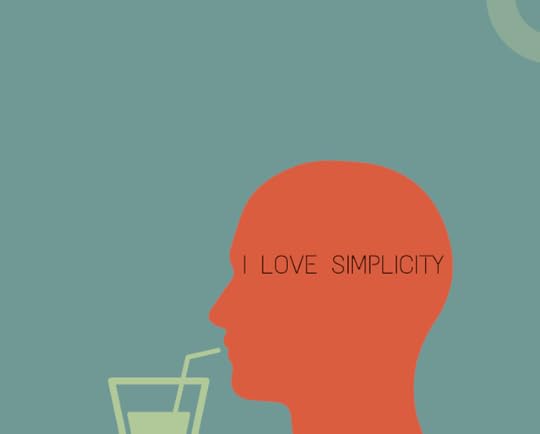
Is Simplicity Actually Worth It?
There’s a trend out there these days that involves learning gurus urging people to seek out simplicity. After all, we naturally shy away from complication, and the sharks know how confirmation bias works. They’re singing exactly the tune most people want to hear.
Instead, I suggest that you ask yourself this difficult question:
“Should I simplify or look complexity in the eye?”
If you really want to experience accelerated learning, I challenge you to avoid the easy route. Stop simplifying things for simplification’s sake.
Learning doesn’t need to be simple, and the best science we have shows beyond a doubt that learning must be challenging in order for growth to take place.
Instead of simplifying information, make it manageable. Not easy, but manageable. In other words, deconstruct the steps involved, just as Tim Ferriss suggests.
Above all, remember to keep flexible. You may need to rework your plans, examine your goals for practicality’s sake, or raise the stakes. For many people, they’re goals actually aren’t lofty enough.
And just get started!
Once in motion, you’ll soon see that everything that once seemed tough looks very different on the other side.
I’m talking about the side of acceleration that you’ll be proud of.
Why?
Because it is real, earned and entirely your own through authentic experience.
The post 9 Awesome Accelerated Learning Techniques [Beyond Mnemonics] appeared first on Magnetic Memory Method - How to Memorize With A Memory Palace.
July 17, 2019
How to Create An UNSHAKABLE Memory Palace Training Routine
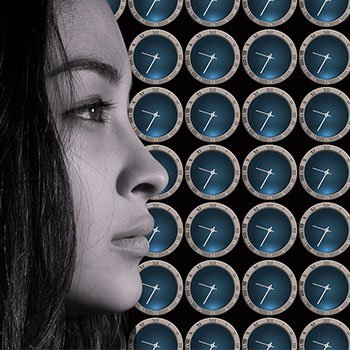 If you want to create an unshakable Memory Palace training routine, here’s the most important point:
If you want to create an unshakable Memory Palace training routine, here’s the most important point:
Your memory exercise routine needs to be immovable from your schedule.
Like a mountain.
Think for a second about what mountains represent:
Mountains symbolize strength, and they dominate the landscape. Mountains endure extreme weather, erosion, and yet remain sturdy.
Now, you may not think of your mind as being as sturdy and consistent as a mountain.
But when it comes to establishing memory ability and the mental power consistent memory training can create in your life, this level of sturdiness is possible.
All it takes is self-discipline, the application of the right techniques, and an established routine you love to maintain.

How do I know?
For one thing, I’ve recited the same passages from memory for nearly two and a half years (Ribhu Gita and Upadesa Saram).
For many years more, I’ve released podcasts, blog posts and videos with (almost) weekly consistency. Only a regular memory practice and personal discipline makes accomplishing such goals possible.
Along the way, I’ve interviewed and made friends with many of the best memory athletes and memory experts on the planet. They’ve inspired me on my mission to spread knowledge about memory techniques as far and wide as possible, and to keep up with memory training each and every day.
Here’s what I’ve learned about Memory Palace training routines along the way.

How To Topple The Biggest Barriers To Consistent Memory Training
First things first, you must master your mindset.
This step will help you eliminate the pain people associate with training, and the flight mode the fear of pain places people in.
Listen, I know it’s easy to get overwhelmed when you’re building your first Memory Palace Network.
Heck, for some people, even the first Memory Palace can be a challenge.
That’s why I created this free course and separated it into smaller and simpler steps:
But here’s the truth:
Even the simplest course in the smallest amount of steps will still challenge you.
Not only is challenge to be expected…
It’s normal! Authentic brain exercise that leads to better memory must be a challenge. Otherwise, you won’t grow.
This fact (one that all scientists and top performers acknowledge) means that challenges are never a reason to accept defeat.
Yet… I’ve heard the same complaint a thousand times:
“Oh this is so much work.” “How will I ever have time for this? What if it doesn’t work?”

How To Escape The “Pain Vs. Gain” Hamster Wheel
Well, what if?
Mental mastery starts with giving up fear of the unknown.
Why is this so important?
Because life is – and always will be – filled with unknowns!
For example, I just started memorizing Chinese characters.
All of a sudden, my brain starts melting under questions for which there is no answer:
What if I spend time on characters I won’t use?
What if I don’t have enough Memory Palaces?
What if I give up?
What if, what if, what if…
The good news is:
I know how to shut these questions about the unknown off. And I can help you. Here’s how:
You need to separate your “pain thoughts” from your “gain thoughts.”
After all, the dread created by thoughts of “so much work” erases the promise of what you stand to gain.
Plus, you can get all kinds of interference, as memory scientists call it, just one of many causes of forgetting.
How To “Flip The Script”
Instead of focusing on the pain, flip the script. Ask instead:
“What if I actually had a fully functional Memory Palace Network and could memorize information quickly? AND not only memorize it, but have it at my fingertips, when I need it?”
Replace focus on the pain with a serious grasp on the outcomes, the benefits, and the goals needed to help you create your first Memory Palace Network. Then create the simple systems that will help you achieve those goals.
Want proof that the Memory Palace technique works? This memory science makes it undeniable! All you need to bring is the practice. The tips below will help. Keep reading!

Fight Vs. Flight:
How to Raise The Fists Of Your Memory And Keep Punching
Are “fight” or “flight” behaviors typical for you?
If you’re not sure, think about the last time you faced a really big challenge.
Did you dive in, or did you sit still and further cement your status as a “couch potato?” through more inactivity? (Let me know in the comments below if you wish.)
Now think about creating that Memory Palace Network (here are some varying examples of this memory technique to help you).
Do you see it as a challenge you can rise to or something to run from?
If you’re running from it, see if you can’t craft a different story for yourself. See yourself diving into battle without fear, for example.
Such a simple shift in mindset really can enable you to make it happen instead of throwing your hands up in the air, admitting defeat and hiding your head in the sand.
You really can harness those runaway, unhealthy, defeatist thoughts. You just need to step back from your ego a bit and objectively view the nature of your thoughts. Or use this simple tip:
Contrary to popular belief, this form of self-inquiry like this does not lead to paralysis analysis.
Instead, an honest analysis of how your mind creates fears and endless self-doubt really can help you take action. You really can start to understand that the barriers you face are really just thoughts in your mind. Walking meditation can help if you don’t like asking and answering these kinds of questions while sitting still.
In all cases, you must take action in order to fully understand how memory techniques work.
Put it this way:
How would you know that you can’t lift Thor’s hammer until that you’ve actually had the handle in your grip?
This is where having a proper mindset separates the wheat from the chaff.
You must have an “all-in” attitude. You’ve got to go for it with laser-focused intent.
The only question is… how do you develop the mindset that allows you to leave your fear and overwhelm about such a “big task” behind?

Use The World’s Most Powerful Cliché And Find Your “Why”
“Know your why” is a cliché, to be sure.
But it works for a reason, and not just because it’s identifiable and relatable.
Thinking about your why causes you to take a long, hard look at your reason behind doing anything, much deeper than surface level reasons like looking smarter or getting a raise.
For this reason, every time we think about our Memory Palace training routines, we will do very well to revisit our why.
How To Dig Into Your Why
Ask yourself “What do I really need these techniques for?”
It is to become a memory champion? To pass exams? To learn languages?
Is it that you want to be able to deal with a large volume of information, or are you more concerned with the speed at which you’re learning and retaining information?
Next, dig deeper.
I recommend that you look for at least five levels of why.
These reasons do not necessarily have to be in a hierarchy of importance. It’s just important that you have enough fuel to draw upon when times get tough or other priorities start to compete with your memory training schedule.
Example of Five Levels Of Why
For example, here are my five levels:
To grow the garden of my knowledge through multiple layers of connection
To deepen my understanding of how world history and philosophy connect
To correct errors where they exist and increase factual accuracy
To increase cultural understanding and communication through ongoing language learning
To maintain brain health through continual brain exercise
You might struggle at first to reach five reasons. Keep practicing and you’ll get there.

The Bucket List Technique
Another way to find your why involves creating a “bucket list.”
Think of the things you would really like to do, and then ask yourself “Why would you like to do them?”
Then ask yourself “Why else?” and repeat.
If you can’t figure out five reasons, or five whys, why you want to do a thing… what are you even bothering wanting to do it for? Do you really want it after all?
This high level “why” will help you not to waste time on training for things you don’t actually want to do, because your training will fall apart if you don’t actually want the goal you set out for.
Do you have to stop at five?
Of course not.
But when you have at least five, you’ll discover it’s easy to complete the next, crucial step: Crafting a Vision Statement.
And as you can see from Joe’s email and extract from his Memory Journal after he watched the video above, this technique really works:

Vision Statement from Joe’s Memory Journal
“Hey professor
July 3, 2019
3 POWERFUL Elaborative Encoding Memory Exercises
 Elaborative encoding isn’t the sexiest term memory science has come up with, is it?
Elaborative encoding isn’t the sexiest term memory science has come up with, is it?
No, but it sure is fantastic when it plays out in real life.
After all, use this memory technique well, and you can memorize a dozen names (or more) at any meeting or party.
Not to mention several dozen details about:
Occupations
Hobbies
Relationship statuses
Locations
Educational and professional backgrounds
… and much, much more!
Imagine being able to remember so much about all the people you meet… within seconds of hearing the details.
Wouldn’t that be a great skill to have?
(If you don’t think so, I’d love to hear why not in the comment section below!)
The best part (when you have these skills)?
You’ll have it all perfectly organized and reachable in your mind. These details will have literally gone from short term memory to long term memory within seconds.
Don’t Fear Memory Science!
Now, I realize that a lot of people hear the scientific terms for how memory techniques work and are immediately turned off.
If that’s you, here’s the blunt truth:
You’re missing out on a huge opportunity to improve your memory by understanding more about how and why it works.
And even though a term like “elaborative encoding” sounds complicated, it is actually:
Simpler than you might think
Something you’re doing already …
And always beneficial to practice so you get better over time
To help you out, I’ve designed three memory-boosting elaborative encoding exercises.
But first, you’ll be best served by understanding exactly what elaborative encoding is.

Effective elaborative encoding is like having a vibrant, multi-connected ecosystem of connections in your mind
What is “Elaborative Encoding”?
Defining elaborative encoding is elementary! Yes, really!
And it’s not so much a thing, as it is a thing you do when using memory techniques.
This simple mental task starts with linking information that you want to remember with existing knowledge.
For example:
There’s a guy named Hunter at Burger Project (in Brisbane) where I go to get grass fed beef burgers (no bun).
I memorized his name almost automatically because I linked the information, Hunter’s name, with information I already know about hunters.
And I put several layers of that information together within seconds of hearing his name. I linked him to a camouflage-clad man with a gun, and not a generic one. Rather, I used my favorite Looney Tunes hunter, Elmer Fudd.

Elmer Fudd with the old Nintendo gun for Duck Hunt worked great as my Magnetic Image for “Hunter”
At the same time, I put that old plastic gun from the Nintendo game Duck Hunt in Hunter’s hand. (Not in reality, but in my imagination.)
By taking his name and associating it with Elmer Fudd and then going one step further and adding Duck Hunt, I was elaborating my mental imagery. In addition to thinking about what all of this looked like, I also:
Heard the sound of a duck-hunting gun and Elmer Fudd’s voice
Felt the Nintendo gun in my hand
Imagined the smell of gun smoke
Imagined the taste of roasted duck
In each case, I made the image weird, larger than life and filled it with vibrant action. Hunter literally shot Elmer Fudd before I started eating him as if he were a duck.
All combined, these layers of elaboration made the name Hunter even more memorable. This process only took a few seconds, and I’ve never forgotten his name since.
What Else Can This Style of Mnemonic Elaboration Be Used For?
Not, you may think that this all sounds fine and dandy for names. But here’s the thing:
Elaborative encoding can be applied to any knowledge.
If you can take that knowledge, make associations and manipulate size, color, speed, duration, distance, mood, emotion, and space… you can memorize anything.
When can elaborative encoding be used?
Any time.
But in the beginning, just focus on the keywords related to the information you want added to your knowledgebase.
From there, you can branch out to more challenging memory tasks, like memorizing scripture.
Otherwise, you’re creating more work for yourself before you have the needed skill set. Why put the cart ahead of the horse?
The Main Tools of Elaborative Encoding
Elaborative encoding is both semantic and echoic.
Semantic encoding has to do with the structure, and oftentimes, meaning of information.
For example, in learning the letters of the alphabet, you probably didn’t start with the letter Q.
Instead, you learned your A, B, Cs through song, in alphabetical order (a structure).
You concentrated on each letter individually as you learned the sound each letter makes.
Later, you learned how to recognize them when written, and how to write them yourself.
The Magisterial Role Of Mental “Free” Association
To take another example, if I say the word “red,” you might picture a stop sign, firetruck, or big, juicy apple. You associate red with its meaning, with examples of that color in the world. This is an element of elaborative encoding.
But that’s not all …
Elaborative encoding can also be echoic, or relating to sound.
It can be the literal interpretation or imitation of sounds, such as onomatopoeia:
A frog croaks, bees buzz, cats meow, and horses neigh.
These sounds are familiar and engrained, so that when we hear a “woof,” we instantly picture a dog.
All of these connections are already in your brain. That’s what makes it so easy to use them along with the classic memory techniques.
Sound like “free” creativity?
It is. The only cost is being human.
What Else Can You Elaborate? …
You don’t have to stop with elaborating your mental imagery. You can also…
Elaborate organization itself.
Look:
Memory Palaces are the go-to tool of most mnemonists. They are in essence the palette upon which we “paint” our elaborative encoding.
Other tools include the alphabet image list of the pegword method, as well as the 00-99 PAO List.
These organizational tools, powerful on their own, can be multiplied by using them in combination with each other. Think of them as elaboration inside of elaboration.
I help you further here:
Elaborate your state.
Think of the state that you’re in. What is it that you’re doing? Are you relaxed, present, and aware, or just simply floating through your day? Make use of relaxation and meditation techniques, even breathing exercises, to elaborate your personal state.
For example, in the beginning, you’ll want to beware of noise. It can distract you as you try to memorize. Later, as memory expert John Graham shares, yo should practice Memory Palaces in both noisy and quiet environments for mental simulation.
Elaborate your memory consolidation.
It is no secret that sleep is very important for memory consolidation, but it is not as widely known that is dependent on your age, meaning memory elaboration decreases with age.
It’s therefore a “no brainer” that we should try to squeeze every ounce of benefit to our memory by practicing good sleep habits, as well as tending to our overall health in general.
This means a proper diet, socialization (face-to-face interactions with others, and a consistent, daily routine, including a morning ritual to start your day off in the best possible way.
So how do we put all these ideas into practice so that our memory improvement efforts flow? With three simple exercises (check this out for more advanced Memory Palace training exercises):

#1: The Abstract Concepts Elaboration Exercise
The goal of this exercise is to practice the elaborative encoding of concepts.
To begin, select a list of non-visual concepts, or words.
Nothing fancy!
Seriously. There’s no need to run to a dictionary of philosophy (though you can if you want).
Just start with concept words you already know. These are words that contain basic concepts and ideas like:
Justice
Truth
Economy
Try to come up with a list of 10 such conceptual words that are already familiar to you.
If 10 is too much, you can always scale back. Challenge yourself appropriately, while avoiding piling on so many concepts that you just wind up frustrated.
Once you have your list established, use a Memory Palace with an appropriate number of Magnetic Stations, and make associations that let you memorize the words on your list.

For example, if you’re a metalhead, Metallica’s …And Justice for All probably comes to mind when you hear the term justice.
In this case, you could use James Hetfield to represent justice. Or maybe an icon of justice has stolen his guitar, and he wants it back.
Are you more of a comic book fan?
No problem! Think about Superman and his infamous tagline, “Truth, justice, and the American way.”
Encode your entire list, making associations with your memory palace, elaborating these associations – maybe Superman is tossing tea on James Hetfield’s guitar, causing Hetfield to seek justice. By bringing the two together…
You’re elaborating elaboration! That is a very powerful way to boost your memory, indeed.
Finally, test the strength of your abstract elaborations. Use Recall Rehearsal as you write out your list into your Memory Journal.
For more practice, add more conceptual words. Now might be the time to get out that dictionary of philosophy!

#2: The Name Elaboration Exercise
Next, put together a list of names.
What kind of names? How about ones that relate to your field of interest?
Are you a budding scientist? List pioneers in your field.
If you’re an aspiring artist, who are your influences?
Are you a talented home cook? Who are some of your favorite professional chefs?
To take another example, memory science is obviously important to me, both personally and professionally. Two innovators in the field are Fergus Craik and Robert Lockheart.
I can remember Fergus Craik by recalling my aunt’s mother who used to live in Fergus, Ontario.
Craik sounds similar to kraken, a mythological sea creature. So, perhaps my aunt’s mother is battling a kraken.
With Robert Lockheart, I remember this same aunt’s brother was named Robert.
While her mom is battling the kraken, Robert is having his heart ripped out by the Loch Ness monster.
Quite an image, right?
Not until it has all of the Magnetic Modes, it isn’t.
I need to add sound, some sense of feeling, and everything taught in the Magnetic Memory Method Masterclass to make sure the images really pop out in my Memory Palaces.
With your list of names, always seek to push the limits. The more “out there,” the more poignant it will be in your mind.
Encode your list, just as you did with concepts, using names, practice Recall Rehearsal, and test yourself.

#3: The Vocabulary Elaboration Exercise
For this exercise, choose vocabulary in your mother tongue.
(Or, for more of a challenge, choose words from a foreign language. Here’s 15 reasons why learning a language is good for your brain.)
Make associations for this vocabulary in Memory Palaces, elaborate the associations, and then test yourself.
If you feel like you’re doing “too much,” or going “too far,” it’s just right.
Focus on the elaboration of the information and elaborate the elaborations. Then you can focus on increasing memory retention.
Push forward and make sure you’re not just settling with good enough in your practice. Good enough will not sharpen your skills when it counts. You need to be challenged.
Your Next Steps Along The Never Ending Memory Adventure…
It’s easy really.
Step beyond the exercises and into the realm of use.
And as many kinds of use as you can.
For example, use these memory exercises in your daily learning practice across multiple disciplines. The more connections you make along your daily learning journey, the faster and more intuitively elaborations will come to your mind.
Finally, challenge yourself.
Try adding numbers to names. Learn the Major Method or Dominic System to make this possible.
Also, mix and match these powerful brain exercises. Use vocabulary paired with names and concepts.
Constantly evolve your practice by adding challenges. Scale back if frustration occurs, and then add more challenge before you’re ready so you keep growing.
Then, the next time you’re at an event and you meet new people, you’ll have no problems whatsoever coming up with the perfect Magnetic Image for each and every person you meet.
Bonus Memory Training Content:
Check out the replay of this training with a live audience in the house. And make sure you’re subscribed if you want to join us for future sessions.
The post 3 POWERFUL Elaborative Encoding Memory Exercises appeared first on Magnetic Memory Method - How to Memorize With A Memory Palace.
June 19, 2019
Delayed Gratification Tips For Memory Training With Matt Dobschuetz
 All self improvement requires delayed gratification, especially memory training.
All self improvement requires delayed gratification, especially memory training.
Now, I’m going to take you on an 180 degree spin, into the heart of a storm many millions of people face. Particularly men.
You see, I get a lot of private questions from people about memory.
And one of them involves online addiction, particularly around porn.
And that leads to compulsive behaviors, one of them being masturbation, more colorfully known as “fapping.”
Guess what?
Too much of it, especially when you’re wired for hours in front of a screen, definitely robs your memory of energy that could be used for memory training.
Worse:
There’s no denying that more of this behavior is happening now than ever before.
The good news is that people have become incredibly frank about the problem.
In fact, I often receive this question in my inbox:
“Should I try a no-fap challenge to help me improve my memory?”
To date, I’ve never addressed the question formally.
An instead of taking the stance and saying, “If porn and masturbation is a distraction from your memory training, eliminate it and see what happens,” I decided to call in an expert.
So let me introduce you to my friend Matt Dobschuetz.
Matt’s the man behind Porn Free Radio and RecoveredMan.com. He is a podcast show host, author and recovery coach for men dealing with addictions to pornography with one on one and group coaching through REV Group Coaching, which he founded.
On this episode of the Magnetic Memory Method Podcast, Matt and I discuss the problems porn addiction creates for your memory training progress.
Memory Vs. Porn Addiction (And How You Can Win)
We cover methods to overcome these memory-robbing impulses, and the science behind why that dependency develops in the first place.
Matt shares his own journey with overcoming porn addiction and we discuss how it relates to memory, and how using memory techniques can help to eliminate porn dependency.
If you struggle with true intimacy with a partner…
If you find yourself gravitating towards masturbation for stress relief …
If your sexual confidence is so low it’s almost nonexistent …
And if you habitually watch pornography and don’t even know why …
This podcast is for you.
Press play now and learn more about:
The rise in pornography accessibility with broadband internet and smartphones
How erectile dysfunction relates to porn dependency
Lack of focus as the result of a pornography habit
The true reason behind lack of confidence in the bedroom
How the experience of failure with overcoming porn addiction can bleed into everyday areas of life (school, work, and even simple conversations with the potential partners)
How to recognize patterns that create opportunities for eliminating porn use and change those destructive patterns to positive growth habits
Relating the Challenge-Frustration Curve to breaking the porn addiction cycle
How to use memory techniques and exercises to overcome porn dependency and porn habit behaviors
What triggers porn addictive behaviors (it’s less automatic than you think)
How to deal with triggers and threats when they occur in real-life situations, both head on and through elimination techniques
Using self-identification as a means to combat porn habit behaviors
Being present and connected as powerful tools for recovery
My biggest takeaway from our interview?
I feel like the issues boils down to an inability to delay gratification. If you’d rather watch this episode of the podcast to discover tips for better strategies, just click play below:
Further Resources From And on the Web:
Recovered Man (Matt’s official website)
“Is Pornography Addictive?” (APA online)
Neuroscience of Internet Pornography Addiction
Surviving PTSD with the Help of Memory Techniques featuring Nicholas Castle
The post Delayed Gratification Tips For Memory Training With Matt Dobschuetz appeared first on Magnetic Memory Method - How to Memorize With A Memory Palace.




